Science Hall [1911]
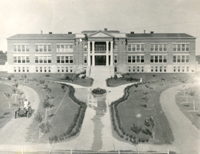 Then:
Then:
First building on the campus of what was then East Central State Normal School. Built by Texas Building Company for $94,700. Both offices and classrooms were housed in the building and the library occupied a single classroom at the southeast corner of the second floor. An auditorium, now known as the Dorothy Summers Theatre, was part of the building as well. In 1939 a fire gutted the theatre. It was suspected that the fire was caused by a careless student smoking.
Now:
Throughout ECU's 100-year history, Science Hall has undergone numerous renovations including the completion of the basement and an expansion of the theatre. Many academic departments have called Science Hall home. At present the nursing department is located on the third floor; the math department is on the second floor, as well as the entrance to Dorothy Summers Theatre; the basement is home to the departments of communication and theatre. Both programs will move to the Hallie Brown Ford Fine Arts Center upon its completion.
Wooden Gymnasium [1913]
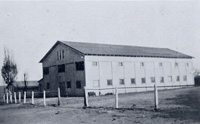 Then:
Then:
The second building on campus was a wooden Gymnasium that was located just southwest of Science Hall. During W.W.I the gym was turned into makeshift military barracks to house a unit of the Student Army Training Corps that was assigned to the campus of ECSNS as part of a nationwide student training program that was headed by the War Department. Cots were moved in and additional bath facilities were built as part of a temporary structure.
Now:
The wooden gymnasium was torn down several, several years ago.
President's Home [1918]
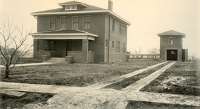 Then:
Then:
Similar president's homes were built at the same time as ECU's at the other normal schools. Designed by architect Jewell Hicks, East Central's president's home cost $4,433. The president's home was occupied by presidents Gordon, Linscheid, Spencer, Wagner and Cole.
Now:
During the late 1990s, the president's home was remodeled and a 3,200 foot expansion was added. On Sept. 2, 1999, the former home was rededicated as the Sterling L. Williams Foundation and Alumni Center. The Alumni Center had previously been located in the northeast corner of the basement of the Memorial Student Union.
Original Horace Mann / Education [1920]
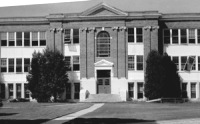 Then:
Then:
The legislative session of 1919 approved funds for the second classroom building at ECU. Originally called the Education Building, its name was later changed to honor famous educator Horace Mann. The new building, which was located where the current Physical and Environmental Science Building is, housed the teacher training school headed by John Zimmerman. In 1925 Horace Mann became an accredited four-year high school in addition to the junior high and elementary divisions of the school.
Now:
In 1953 the new Horace Mann building was completed and the original Horace Mann was used by the departments of art and music for a few years. In the early 1960s the building was used as a men's residence hall. In 1969 - 1970 the original Horace Mann building was torn down.
Charles F. Spencer Administration Building [1926]
![Charles F. Spencer Administration Building [1926]](/sites/default/files/inline-images/building_oldAdministration%20building.jpg) Then:
Then:
Completed in 1926 at a cost of $130,000 the Administration Building housed the library, all administrative offices and the departments of English and history. A two-story addition, close to the original size of the building, was added on the west side with a center hallway connecting the old and new parts of the Administration Building. In 1976 the building was named the Charles F. Spencer Administration Building in honor of ECU's fourth president.
Now:
Today the Charles F. Spencer Administration Building is home to the majority of the administration offices including the Admissions and Records Office, Financial Aid Office, Bursar's Office and Student Development. The second floor is home to the school of business and accounting along with ITV classrooms that enable classes to be conducted at off-site locations via satellite.
McBride Gym [1927]
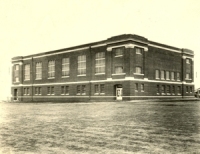 Then:
Then:
Completed in1927 for $110,000 and originally named the Health Education Building, the gym featured a basketball court and swimming pool in addition to classroom space. In 1974 the Health and Education Building was renovated and renamed the Mickey McBride Health Building in honor of ECU legendary basketball coach Mickey McBride.
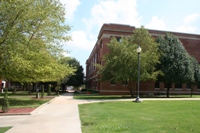 Now:
Now:
Today the red brick building is called by most students and alums McBride Gym. During construction of the University Center in 1997, McBride underwent renovations once again and was connected to the new University Center. The swimming pool is still in much use, mainly due to swimming and water aerobic classes offered through by Continuing Education. The upper floor features the basketball court with an upper level walking track. The Career Development Office is also located in McBride.
Norris Field [1930]
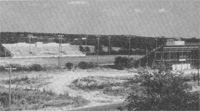 Then:
Then:
ECU's first football games in 1909 were held east of the Katy Railroad tracks between 12th and 14th streets. The next year, the playing field was moved to the south side of Science Hall. Bleachers were built about five years later. In 1927, Mr. and Mrs. P.A. Norris donated 11.43 acres of land adjoining the east side of campus for a new athletic field. In 1930 grandstands were built to seat about 1,600 people. Ten additional acres were purchased to expand the football field and the east side stands were built.
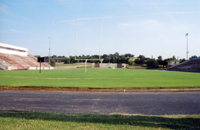 Now:
Now:
The current "home-side" stands were built in 1970 and have seen much use including the 1993 NAIA National Championship won by the Tigers. During the summer of 2008, the outside of the stadium was repainted and new bleachers are planned to replace the current "home-side" stands.
Knight Hall [1937]
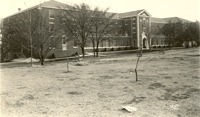 Then:
Then:
One of two residence halls built in 1937 by architect Albert Ross through a request to the Public Works Administration from President Linscheid, Knight Hall was built to house 178 women. The residence hall was named after long-time original faculty member Kate K. Knight. During the 1950s and 1960s a popular story was spread that Knight Hall was haunted. Tales of thumping noises and cold burst of air were common and reached such frenzy that President Wagner had Kate Knight's portrait removed from the building's lounge. In 1977 Knight Hall was remodeled and the former student lounge was named the James Thomas Regents Room.
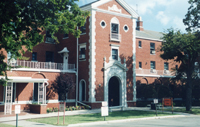 Now:
Now:
Today Knight Hall is designated as the Honors Hall for co-ed students participating in the honors program. The rooms are efficiency style apartments for honors students and/or students above a sophomore status. The Regents Room is used for both university and public meetings and ceremonies. Kate Knight's famous portrait is back at Knight Hall in the Regents Room.
Fentem Hall [1937]
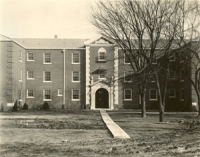 Then:
Then:
One of two residence halls built in 1937 by architect Albert Ross through a request to the Public Works Administration from President Linscheid, Fentem Hall was built to house 112 men. The residence hall was named after long-time originally faculty member Alfred L. Fentem. In 1956 a three-story addition was added to Fentem Hall to house 60 more men. By 1974 Fentem Hall was no longer in use as a residence hall and in 1976 the first floor was turned into office space and in 1978 the building was remodeled via a special grant to remove handicap barriers.
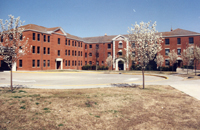 Now:
Now:
In 1988 Fentem Hall received a $500,000 face lift including the creation of a day care center and expanded office space for ECU's Center of Continuing Education and Community Services, both of which are still housed at Fentem Hall. Also located inside Fentem Hall are the School of Graduate Studies and the McNair Scholars Program.
Linscheid Library [1949]
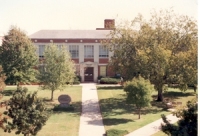 Then:
Then:
Contracted in 1948 by the Harmon Construction Company in Oklahoma City at the cost of $322,500, the library was dedicated on Oct. 23 1949, and named in honor of long-time ECU president Adolph Linscheid. In 1963 the library was enlarged and remodeled again in 1976.
Now:
The new Linscheid Library, built into the steep hillside just south of the Education Building, was dedicated on Oct. 23, 1997 in a re-enactment ceremony of the dedication of the former Linscheid Library on Oct. 23, 1949. The new building has 74,020 square feet of library space including a special collection archive room and an audio visual department. The former Applied Science Building was annexed and became included in the new library. The Linscheid Library is still used in the same capacity as when it was built in 1997. The former Linscheid Library is now Danley Hall.
Memorial Student Union [1951]
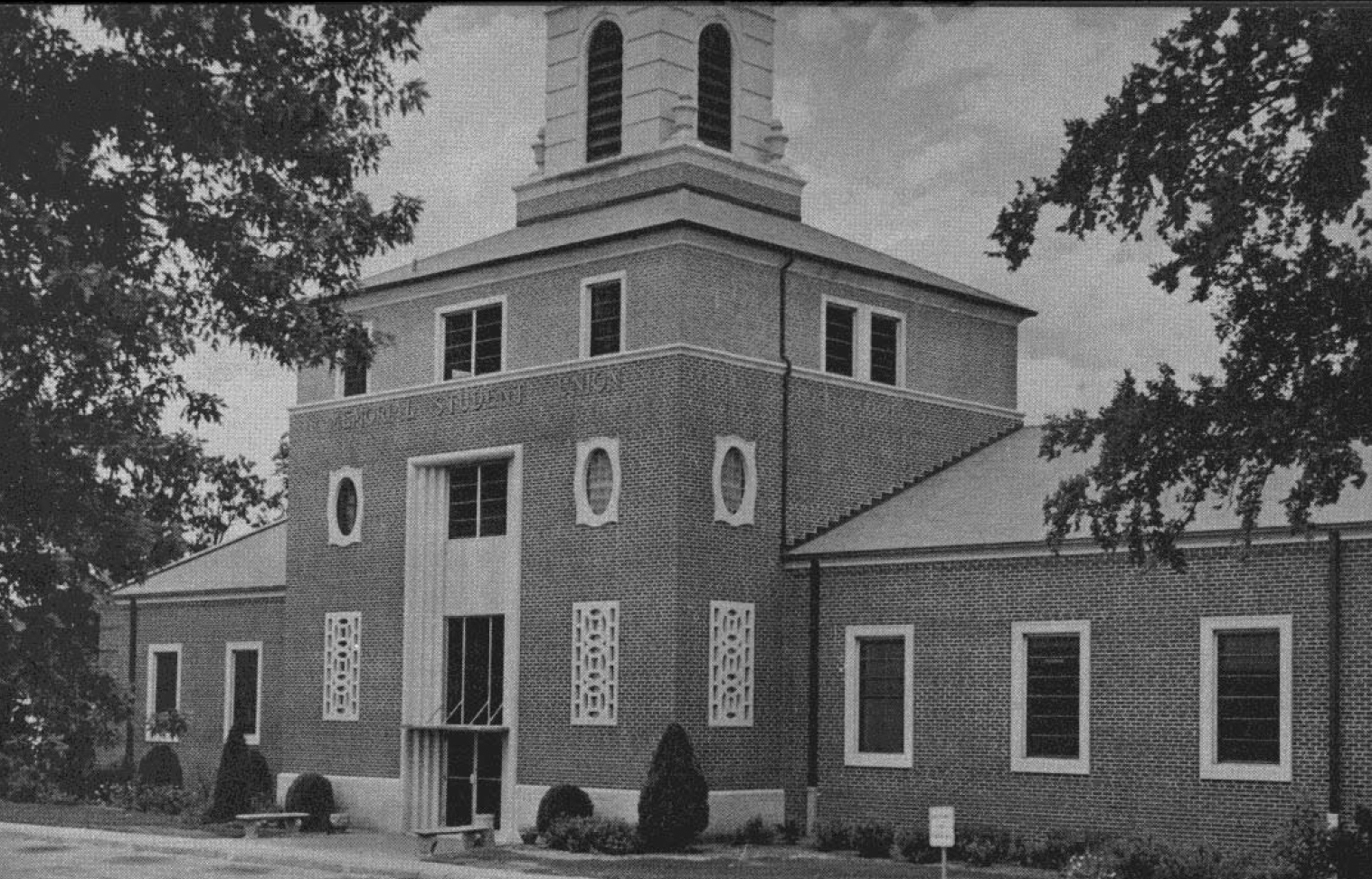 Then:
Then:
Designed by local architect Albert Ross, the Memorial Student Union was built in honor of ECU students who had served and died during W.W.II. The new structure was design primarily for student use featuring a ball room, snack bar, recreation rooms, lounges and book store. The building was enlarged later by addition of a game room. In 1998 a $550,000 renovation was completed creating space for meeting rooms, expanded university book store and health services clinic. The ballroom was also refurbished and named in honor of ECU's fifth president Dr. Stanley Wagner.
Now:
The ECU bookstore, student mailboxes, north lounge, Oklahoma room and ballroom are all still in use today. The Journal, ECU's student newspaper, is located on the third floor of the Memorial Student Union while the health services clinic and student counseling center are located on the second floor.
New Horace Mann [1953]
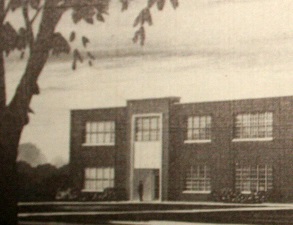 Then:
Then:
Built in 1953 on the west side of campus between 12th and Main streets, the new Horace Mann building was home to the teacher training or laboratory school until its discontinuation in 1960, at which time the business, art and music departments occupied the building. In 1967 a three-story addition was added tripling the floor space. The departments of English, government, history, home economics, sociology, geography and physics moved to the new space. The original part of the building was renamed Faust Hall after ECU alum and long-time resistor Harvey Faust.
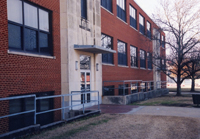 Now:
Now:
Horace Mann's third floor is currently home to the English department and the Hayes Native American Center. The second floor contains the departments of history, political science and legal studies, human resources and sociology. The first floor or basement house the department of cartography and geography.
Faust Hall [1953]
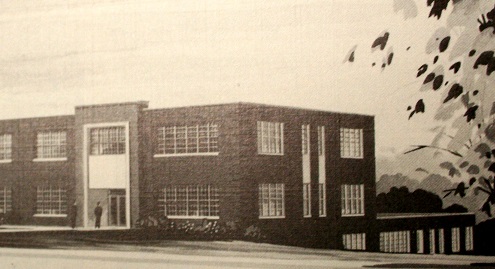 Then:
Then:
Built as the second Horace Mann building in 1953 and used as such until its discontinuation in 1960, Horace Mann became Faust Hall after 1967 when a three-story addition was completed. The new part became known as Horace Mann while the older part of the building became Faust Hall, named after ECU alum and long-time registrar Harvey Faust.
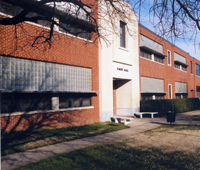 Now:
Now:
Today Faust Hall is home to the departments of music, dance and family and consumer sciences.
Education Building [1957]
Then:
Built to house the departments of education, psychology and industrial arts was completed in 1957. Prior to its construction the industrial arts department had been housed in temporary war surplus buildings after moving from the sub-basement of Science Hall. The Education Building was enlarged in 1968 and again in 1974, at which time the art department was moved to the lower level of the building.
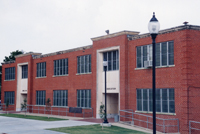 Now:
Now:
Today the Education Building is still home to the departments of education, psychology and art. Upon completion of the Hallie Brown Ford Fine Arts Center, the art department will move to the new facility. The Education Building also houses the services to the deaf office, veterans upward bound and veteran's workforce investment program.
Kathryn P. Boswell Memorial Chapel [1957]
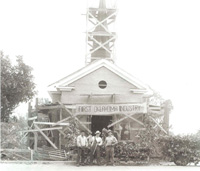 Then:
Then:
The chapel was a gift to ECU from Mr. S.C. Boswell in memory of his wife and was intended to be used by religious groups on campus, weddings and other special occasions.
Now:
The Boswell Memorial Chapel is still used for small weddings, sorority/fraternity ceremonies and special occasions.
Briles Hall [1962]
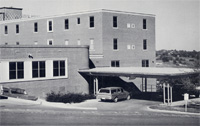 Then:
Then:
Construction began on Briles Hall in 1962 and was the first residence hall built since 1937. Briles was built as a residence hall for women. It is five stories with a capacity of 161. The residence hall is located directly east of Knight Hall and the two were connected with a new cafeteria, known as Taff Cafeteria. Briles Hall was named in honor of ECU's first president Charles Briles.
Now:
Briles Hall still primarily houses women. However, it is the only hall which is handicapped accessible so it houses men and women as necessary. Normally, individuals of sophomore status or higher live in Briles.
Family and Adult Housing [1964]
Then:
Originally known as married student housing, these three two-story apartment buildings were built in 1964 for students with families. They were built south of Norris Field. Four years later two additional apartment buildings were built. All five buildings contain 95 housing units.
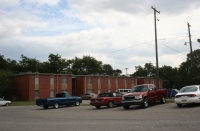 Now:
Now:
Today the Family and Adult Housing apartments are used for students with families and non-traditional students.
Pontotoc Hall [1964]
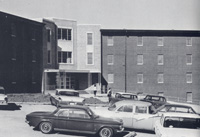 Then:
Then:
Built in 1964, this Y-shaped structure is four-stories and can house up to 420 students. Pontotoc Hall was named for Pontotoc County and was built to be used by either male or females depending on the need for space.
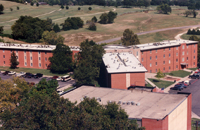 Now:
Now:
Pontotoc Hall is now used as a coed athletic residence hall.
Pesagi Hall [1965]
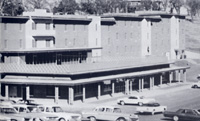 Then:
Then:
Pesagi Hall, named for the Chickasaw word that means "teacher," Pesagi is four-stories and can house up to 420 students. It was built to be used by either male or females depending on the need for space.
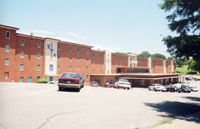 Now:
Now:
Currently, Pesagi Hall is coed and used as ECU's First Year Experience residence hall. All freshmen are required to live in Pesagi Hall which also features a coffee shop/convenience store called Outtakes.
Robert S. Kerr Activities Center [1974]
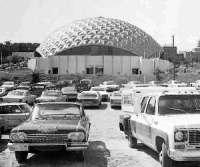 Then:
Then:
The Kerr Activities Center, or Kerr Dome, was built due to the fact ECU had outgrown the use of an aging McBride Gym. President Wagner wanted a design that would be unique and attract visitors to ECU's campus. Kerr was modeled after a geodesic dome in Shreveport, Louisiana. Built by United Builders in Shawnee, Okla. at a cost of $859,460. The Kerr Activities Center was named in honor of ECU alum, Oklahoma governor and U.S. senator, Robert S. Kerr.
Now:
Today the Kerr Activities Center is home to the athletic offices and is still in frequent use for events ranging from basketball and volleyball games to science fairs to ECU'graduation ceremonies.
Elvan George Athletic Building [1980]
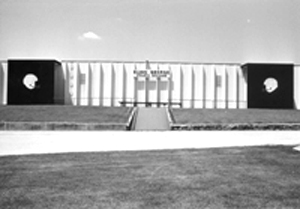 Then:
Then:
Named in honor of ECU legendary football coach, Elvan George, the athletic building cost $125,000 and was contracted by local resident Gerald Philpot who donated his labor and construction equipment to the project. The facility provided updated dressing rooms for the football team and a weight training area.
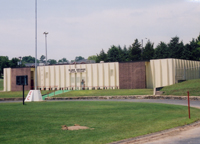 Now:
Now:
The Elvan George Athletic Building is still used in its same capacity today. There are plans underway to renovate this building.
Instrumental Music Building [1980]
Then:
Built at a cost of $300,000, the Instrumental Music Building features 10,000 square feet of space for band and instrumental music majors. The new building was also designed so that its elevator provides easy access to the lower part of campus for handicapped students.
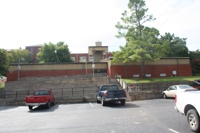 Now:
Now:
Today the Instrumental Music Building is still home to ECU's band. Upon completion of the Hallie Brown Ford Fine Arts Center, the instrumental music department will relocate to the new facility.
Physical Plant [1980]
Then:
Located northeast of the football field, the 15,000 square foot facility replaced the old maintenance building that was located within the main part of campus. The former building was renamed the Applied Science Building and housed the ROTC. That building is now an annex to the new Linscheid Library.
Now:
The Physical Plant currently in the same location.
Physical and Environmental Health Sciences Building [1991]
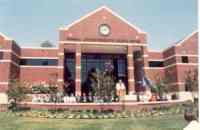 Then:
Then:
Begun in May 1989, at the price of $4.189 million, this new building emphasized energy efficiency while locating all of its 27 laboratories at the center for the two-story building. On March 21, 1991, before construction was complete, a tornado took out the north wall of the building causing $55,000 in damages. The 50,000 square foot building was dedication on Aug. 1, 1991.
Now:
The P&ES Building is home to the departments of environmental health science, biology, chemistry, physics, computer science and pre-professional programs.
University Center [1997]
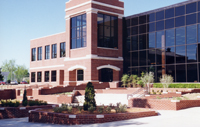 Then:
Then:
Dedicated on Jan. 17, 1997 the University Center cost $4.3 million and features the 144-seat Raymond Estep Multimedia Center, Tommy Hewett, M.D. Wellness Center, snack bar and meeting rooms. The building is located on the south side of McBride Gym and the two were connected during construction.
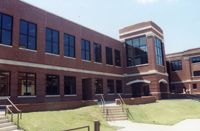 Now:
Now:
The University Center, known on campus as the UC, is one of the main hubs of recreational activity for students. In 2006 pool, ping-pong and foosball tables were brought into the UC along with TV's and X-boxes. The next year, Starbucks was added to the snack bar.
Frank R. Crabtree Sr. Honor Plaza [1999]
Then:
Located in front of Science Hall, the Honor Plaza features a water fountain with a bronze tiger. The fountain is surrounded by granite benches which have been placed in honor of individuals or events significant to ECU history. The Honor Plaza was dedicated on Veteran's Day, 1999.
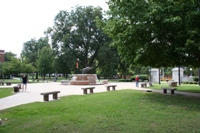 Now:
Now:
The Honor Plaza still stands today with more benches placed since 1999.
Danley Hall [2003]
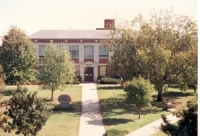 Then:
Then:
Built in 1949 as the Linscheid Library.
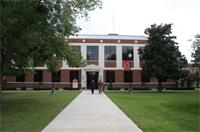 Now:
Now:
The building was gutted, renovated and re-opened in 2003 as the James O. Danley Center for Administration and Instruction - or more commonly known as Danley Hall. Danley was a former faculty member and graduate dean. The President's office and Academic Affairs are housed on floor 2R while the second floor contains the department of institutional research and grant development offices. The transfer enrollment center, writing lab and computer help desk along with the information technology department are located on the first floor of Danley Hall. Also on the first floor is three-story atrium which provides a quiet place to study and visit. The atrium is also used for special receptions and ceremonies.
